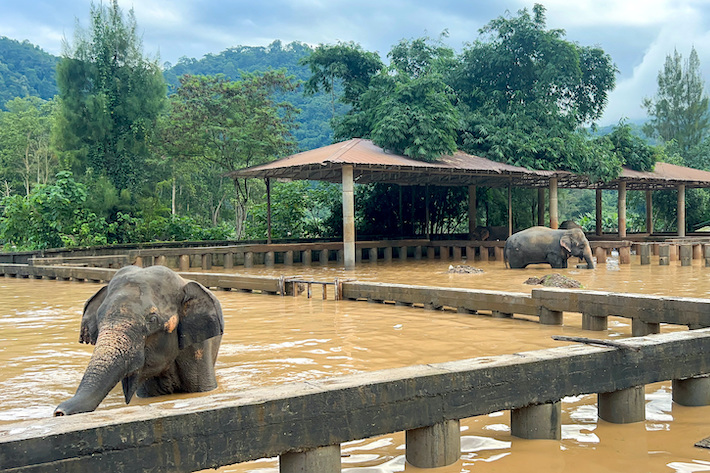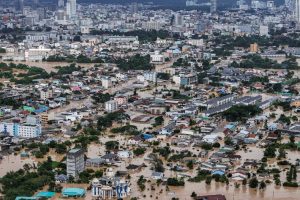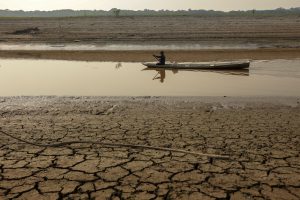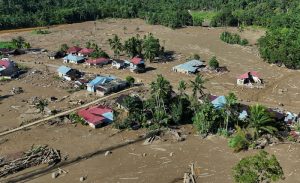For people living in regions across Asia that have suffered intense flooding in recent months, the latest global weather report may seem confusing or just plain wrong.
Millions of people living in parts of eastern or southern China, northern Vietnam, Laos, Thailand, Myanmar and southern India were hit hard last month by severe and dramatic floods, which in some places were hailed as the ‘worst in a century’.
However, a new report by the UN World Meteorological Organization (WMO) says many of the world’s major river basins were drying up last year and that the world’s rivers had their driest year in at least three decades.
ALSO SEE: SE Asia Crime Networks Rely on Telegram, Crypto, UN Says
Weather conditions in 2023 contributed to “extreme heat and diverse weather impacts ranging from heavy rains and floods to droughts,” the report’s executive summary said.
Warming is fuelling both heavier rainfall and more intense drought. With the planet heating up, “we are facing growing problems of either too much or too little water,” Celeste Saulo, secretary-general of the WMO, said.

Large parts of North, Central and South America suffered severe drought and reduced river discharge, with “the Mississippi and Amazon basins at record-low water levels” because last year was the hottest on record, with temperatures 1.45C above pre-industrial levels.
Meanwhile, the east coast of Africa experienced above and much-above-normal discharge, while the Horn of Africa, which had suffered five consecutive dry rainy seasons, was affected by flooding.
“In Asia and Oceania, large river basins – the Ganges, Brahmaputra and Mekong – experienced lower-than-normal conditions over almost their entire basin territories, it said.
Like 2022 and 2021, over half of global catchment areas saw a deviation in river discharges that were “predominantly lower than normal,” it said.
Lake Coari in the Amazon faced below-normal water levels, leading to extreme water temperatures, and Lake Turkana, shared between Kenya and Ethiopia, had above-normal volumes, following much-above-normal river discharge conditions.
North America and Europe suffered a drop in groundwater levels due to prolonged drought, but other regions such as South Africa, India, Ireland, Australia and Israel enjoyed showed above-normal groundwater levels in their wells.
Largest loss of glacial mass in 50 years
Glaciers lost more than 600 gigatons (Gt) of water – the largest mass loss registered in the last five decades. It was the second consecutive year in which all glaciated regions reported ice loss.
Glaciers in Europe, Scandinavia, the Caucasus, northwestern Canada, western South Asia and New Zealand have all passed “peak water” – the threshold of maximum runoff due to melting, it said, while the southern Andes, Patagonia, the Russian Arctic and Svalbard seem to be seeing increasing melt rates.
In terms of human impact, Africa was the continent most affected by extreme hydrological events, it said, as 11,000 lives were lost when two dams collapsed in Libya due to flooding, in a tragedy that affected nearly a quarter of the country’s population.
Floods also affected the Horn of Africa, the Democratic Republic of the Congo, Rwanda, Mozambique and Malawi, leading to additional toll of over 1,600 deaths, it said.
It was either one extreme or the other, with widespread drought affecting the southern United States, Central America, Argentina, Uruguay, Peru and Brazil, leading to a 3% loss in gross domestic product (GDP) in Argentina and the lowest levels ever observed in the Amazon River and Lake Titicaca.
While drought has had a major impact on farm and crop yields, flooding and extreme weather has also caused severe damage to infrastructure and housing in many areas. China alone suffered economic losses totaling more than $40 billion last year.
- Jim Pollard
ALSO SEE:
LNG’s Carbon Footprint 33% Bigger Than Coal’s – CC
Forest Fires a Double Whammy for Climate Change Fight – Guardian
Continued Fossil Fuel Investments Put $557 Trillion ‘At Risk’
Huge Storms Battering China, Causing Chaos in Southeast Asia
Vietnam Counts Deadly Cost After Typhoon Yagi Sweeps Through
China’s Billion-Ton Coal Expansion Plan Sparks Methane Fears
Climate Change ‘Fuelled’ Rain That Led to Fatal Indian Landslides
Extreme Weather Cost China More Than $10 Billion In July Alone
Typhoon Pounds China’s Fujian After Lashing Taiwan, Manila























